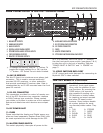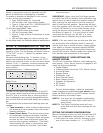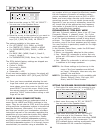
SP2 PREAMP/PROCESSOR
ers.
Surround Modes:
HALL: This Sound Field Mode emulates a medium
or large concert hall. It provides a longer reverber-
ation time than other modes and gives the effect
that music is heard at a greater distance from the
performers. It is ideal for orchestral classical music
and light orchestral music, such as that found on
many film soundtrack albums, but this mode will
generally sound a bit muddy on rock or pop music.
THEATRE: This Sound Field Mode simulates a
room larger than a club, and it is intended to simu-
late what you would hear in the front rows in a
medium-size theatre. The reverberation here is
not overly obtrusive, since a theatre is intended
for clarity of speech. This mode is suited for opera,
rock, easy listening music, and any music you
might hear in a theatre.
STADIUM: This Sound Field Mode provides a
prominent “slap echo,” emanating largely from
the rear, and it gives a lively effect especially on
solo instruments such as bass guitar. This mode is
unsuitable for speech as the echo destroys intelli-
gibility. The sound is “big” but slightly artificial — it
is suitable for stadium rock, and other music that
one would hear in a large stadium environment.
CLUB: This Sound Field Mode is intended to
simulate being fairly close, around 10 feet away,
in a small intimate club setting with a moderate
amount of reverberation that does not destroy
clarity. The result is a bit colored for speech due
to the small room size, but it is quite suitable for
jazz groups, cabaret, small-venue rock ‘n roll, and
a small disco venue where dance music is played.
This mode can also be used for classical chamber
music and solo instrumental music of most kinds.
CHURCH: This Sound Field Mode simulates a
large, spacious acoustic space with a very long
reverberation time. It is well-suited to organ
music, choral music, and New Age music. It is too
reverberant for most other kinds of material, but it
is very spacious for material it is suited to.
Natural: This mode enhances the basic ste-
reo reproduction by using the inherent acoustics
recorded within the source material. If the source
material was surround encoded or recorded in
an acoustically oriented manner (such as a lot
of classical music and many live recordings) this
mode can provide truly spectacular effects and an
enhanced sense of the space in which the music
was being performed.
PARTY: The Party (Five-Channel Mono) Mode con-
verts stereo input to a mono signal which is then
distributed to the five satellite channels.
Stereo5: The Stereo5 (Five-Channel Stereo) Mode
converts stereo input to surround sound. The ste-
reo signal is distributed to the five satellite chan-
nels, creating a giant stereo image in your listening
space.
(Please note that the apparent effect of the
Surround Mode can be adjusted by altering the
delay parameters and channel volume of the cen-
tre, surrounds and back channel(s), using the
appropriate menus).
NOTE: Remember there really are no “correct”
settings that will work equally well for all kinds of
music. You may need to adjust the parameters and
mode depending on the music material.
Acknowledgements
Manufactured under license from Lucasfilm Ltd. U.S. patent numbers
5,043,970; 5,189,703; and/or 5,222,059. European patent number
0323830. Other U.S. and foreign patents pending. Lucasfilm and THX
are trademarks or registered trademarks of Lucasfilm Ltd. Surround EX
is a trademark of Dolby Laboratories. Used under authorization.
Manufactured under license from Digital Theater Systems, Inc. US Pat.
No. 5,451,942; 5,956,674; 5,974,380; 5,978,762 and other world-wide
patents issued and pending. “DTS”, “DTS-ES Extended Surround” and
“Neo:6” are trademarks of Digital Theater Systems, Inc. Copyright
1996, 2000 Digital Theater Systems, Inc. All Rights Reserved.
Manufactured under license from Dolby Laboratories. “Dolby”, “Pro
Logic”, and the double-D symbol are trademarks of Dolby Laboratories.
Confidential unpublished works. Copyright 1992-1997 Dolby
Laboratories. All rights reserved.
ALL TRADEMARKS, REGISTERED MARKS, AND LOGOTYPES/
SYMBOLS ARE THE PROPERTY OF THEIR RESPECTIVE
16


















